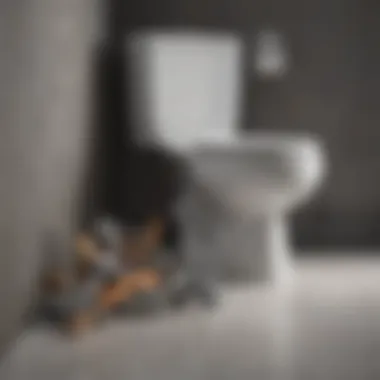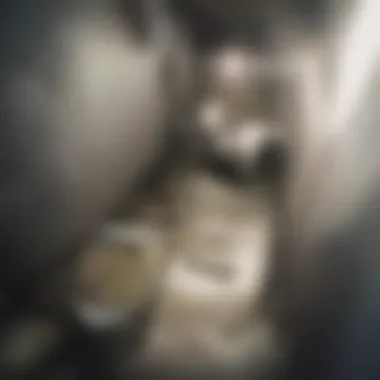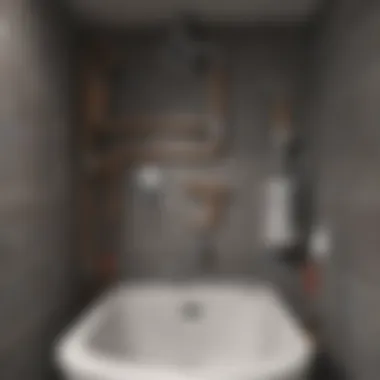Understanding Clogged Toilet Drains: Causes and Solutions


Intro
Clogged toilet drains are an all too common issue in household plumbing systems. They can lead not only to frustration but also to costly repairs if left unaddressed. Understanding the various causes behind these clogs, their implications, and the ways to resolve and prevent them is crucial for maintaining plumbing efficiency. This article delves into the complexities surrounding clogged toilets, aiming to equip homeowners with effective solutions and preventive measures.
Key Points to Discuss:
- Causes of Clogs: Understanding what leads to toilet blockage.
- Implications: Effects on plumbing and overall hygiene.
- Solutions: Practical methods for unclogging.
- Prevention: How regular maintenance can avert future problems.
- Professional Help: Signs that indicate the need for an expert's assistance.
A comprehensive grasp of toilet drainage issues not only enhances daily living but also contributes positively to property value. This knowledge serves as a valuable tool for homeowners and individuals interested in real estate or plumbing systems.
Prologue to Clogged Toilet Drains
Definition and Overview
A clogged toilet drain refers to a blockage that restricts or prevents waste and water from flowing freely through the plumbing system. It occurs when objects, excessive waste, or debris accumulate and obstruct the passage. This can manifest in various ways, such as slow drainage or complete stoppage. The plumbing system in modern homes relies on gravity and proper ventilation to function, making it essential for all components to operate without hindrance. When clogs develop, they disrupt this balance, often necessitating immediate attention.
Importance of Addressing Clogs Promptly
Promptly addressing toilet drain clogs is vital for several reasons. Firstly, ignoring a minor blockage can lead to more severe clogs over time, which can be more difficult and expensive to clear. Secondly, a completely clogged toilet can cause unsanitary conditions, leading to health risks and unpleasant odors. Delayed action may result in the need for professional plumbing services, which can be costly compared to simple DIY solutions.
"Routine maintenance of plumbing systems can prevent many issues that arise from neglect."
Moreover, unresolved clogs can damage the plumbing infrastructure, resulting in more extensive repairs. Regularly monitoring the functionality and being aware of any changes can mitigate these risks significantly.
Common Causes of Clogged Toilet Drains
Understanding the common causes of clogged toilet drains is essential for mitigating household plumbing issues. Addressing these causes swiftly not only saves you time but also minimizes potential damage and costs associated with plumbing repairs. An awareness of these triggers allows homeowners to take preventative measures before a minor issue escalates into a significant problem.
Excessive Toilet Paper Use
Overusing toilet paper is a leading contributor to clogged drains. This issue arises when individuals flush more paper than the plumbing system can handle. While toilet paper is designed to disintegrate in water, excessive amounts can clump together, creating blockages. It is advisable to limit usage and consider alternatives for individuals who require more than typical amounts.
Ultimately, moderation is key in preventing such clogs.
Foreign Objects
Foreign objects present an obvious yet often overlooked cause of toilet blockages. Items such as toys, personal hygiene products, and other non-flushable materials frequently find their way into the toilet. Once flushed, these objects can become lodged in the plumbing system, hindering the flow of wastewater. Always ensure that children are informed about toilet usage to reduce the risk of accidents. Additionally, keep the bathroom environment free of items that can easily be disposed of in the toilet.
Flushing Inappropriate Items
Many homeowners underestimate the impact of flushing inappropriate items. Items like paper towels, food items, and feminine hygiene products should never be flushed. These materials do not break down easily and can lead to serious blockages. It is crucial to educate all household members about the proper use of toilets and establish a habit of disposing of these items correctly in waste bins. This simple change can have a significant effect on plumbing health.
Drain Pipe Issues
Sometimes the root of the problem lies within the drain pipes themselves. Aging pipes or those with structural issues can restrict water flow, causing clogs. Moreover, misaligned or broken pipes can prevent waste from moving smoothly through the system. Conducting regular inspections and maintenance of plumbing can help catch these issues early. Homeowners should not hesitate to employ professional help if they suspect their pipes are causing persistent clogs.


Build-Up of Mineral Deposits
The build-up of mineral deposits, particularly in areas with hard water, can also cause clogs. Over time, minerals like calcium and lime can accumulate inside pipes, narrowing them and restricting flow. This problem can be exacerbated by low water pressure and infrequent use of water in certain fixtures. Regular cleaning and descaling of pipes can mitigate mineral build-up. Homeowners might consider installing water softeners to reduce the impact of hard water in their homes.
Prevention is always more effective than cure when it comes to clogged drains.
By understanding these common causes, homeowners can better manage their plumbing systems. Prevention and education are critical in avoiding costly repairs and maintaining a healthy plumbing environment.
Consequences of Ignoring Clogged Toilet Drains
Ignoring clogged toilet drains can lead to significant issues that extend beyond mere inconvenience. While it may seem tempting to postpone addressing a clog, doing so can have serious implications for hygiene, property damage, and overall costs. Understanding these consequences can encourage proactive measures and prompt action when faced with such plumbing issues.
Impact on Hygiene
A clogged toilet drain can create unsanitary conditions in the home. Toilets are meant to handle waste efficiently; when they do not work correctly, waste may back up into the bowl or, in worse scenarios, overflow. This not only presents an unpleasant sight but also creates a breeding ground for harmful bacteria and pathogens. By neglecting a persistent clog, households expose their members to increased health risks. Maintaining cleanliness and hygiene is essential, and addressing toilet clogs promptly is a crucial aspect of this effort.
Potential for Water Damage
Another significant consequence of ignoring clogged toilet drains is the potential for water damage. Clogs that lead to overflow can cause water to seep into floors, walls, and other critical areas. Over time, this can result in mold growth, which poses its own health risks and could lead to further damage to structural materials. Any leaks or water damage may compromise the integrity of the home, leading to costly repairs down the line. Hence, one should not overlook the relationship between plumbing issues and their repercussions on overall property condition.
Increased Repair Costs
Lastly, failing to address clogged toilet drains in a timely manner often results in increased repair costs. What might start as a simple clog can escalate into a more complex problem requiring extensive solutions. For example, persistent clogs might necessitate professional intervention, including the use of specialized tools and techniques to clear the blockage. Each intervention adds layers of expense that could have been avoided through early action. By recognizing the financial implications involved, homeowners can take more proactive steps to maintain their toilet systems and minimize long-term costs.
Addressing a clogged toilet drain quickly saves time, money, and effort in the long run.
Identification of Clogged Toilet Drains
Recognizing a clog is crucial for maintaining a functional plumbing system. Ignoring early signs can lead to significant issues, including costly repairs and health risks. This section will delve into the signs of clogged toilets and effective ways to assess the situation.
Signs of a Clogged Toilet
Several indicators suggest that a toilet is becoming clogged. Being aware of these signs can help homeowners address the problem promptly. Common symptoms include:
- Slow draining: Water in the bowl rises slowly after flushing, indicating a partial blockage.
- Gurgling sounds: Unusual noises from the toilet or nearby drains may signal air trapped in the plumbing.
- Overflowing toilet: When flushing leads to water spilling over the bowl, it's a clear sign that something is obstructing the passage.
- Foul odors: Persistent unpleasant smells can indicate waste buildup in the pipes.
- Frequent backups: Repeated clogs, even after using a plunger, warrant immediate attention.
Recognizing these signs early can save homeowners from potential health hazards and more significant plumbing issues.
Assessment Techniques
After noticing the signs of a clog, assessment techniques are essential. Understanding the severity and location of the blockage can guide homeowners on how to proceed. Here are some strategies to assess the situation:
- Visual Inspection: Start by checking the toilet bowl. If it appears unusually full or exhibits standing water, this may be a sign.
- Listen for Sounds: Engaging your sense of hearing can be informative. Listen for gurgling noises. This can indicate air escaping due to a blockage.
- Check Other Fixtures: Assessing other drains and sinks in the house can provide insights. If multiple drains are slow or gurgling, the clog might be deeper in the plumbing system.
- Flushing Test: Flushing the toilet can act as a simple test. If the water does not drain efficiently, it confirms that there is a blockage.
- Water Level Check: Maintain an eye on the water level in the bowl. If it does not return to normal after a flush, deeper investigation is necessary.


By employing these assessment techniques, homeowners can avoid unnecessary actions and determine whether they can clear the clog themselves or should seek a professional's expertise.
"Early detection of toilet clogs can prevent larger plumbing issues and costly repairs."
In summary, effective identification and assessment of clogged toilet drains are vital for maintaining good hygiene and protecting a home’s plumbing system. This knowledge empowers homeowners to act decisively and often keeps minor problems from escalating into significant repairs.
Methods for Clearing Clogged Toilet Drains
Addressing the issue of clogged toilet drains is essential for maintaining a functional and hygienic bathroom. One must understand that several methods exist to clear these clogs, and each method has its own unique benefits and considerations. It is critical to select the appropriate technique based on the severity of the clog and the resources available. Implementing these methods efficiently not only restores functionality but also helps prolong the lifespan of plumbing systems.
Plunger Usage
The plunger is perhaps the most recognizable tool in the arsenal against toilet clogs. This simple device, often distinguished by its rubber suction cup, creates a powerful force when used correctly. To properly use a plunger:
- Ensure the plunger is the right type, ideally a flange plunger, which is designed specifically for toilets.
- Submerge the plunger in water so that it creates a good seal around the drain.
- Apply firm, quick thrusts, pushing down and pulling up. The pressure changes can help dislodge the blockage.
However, it does require some physical effort. It is crucial to remain patient and organized during the process. If multiple attempts fail, it may be time to explore other methods.
Auger Techniques
An auger, also known as a plumbing snake, is another effective tool for clearing clogs that a plunger cannot resolve. This metal coiled tool can navigate through bends in pipes, allowing it to reach and break apart more resilient blockages. To use an auger:
- Insert the end of the auger into the toilet bowl and turn the handle to dislodge the clog.
- Be cautious, as excessive force can cause damage to the toilet bowl or pipes.
Using an auger may seem intimidating, but understanding the mechanics makes it achievable for most homeowners. If the clog persists, it indicates a more significant problem deeper within the plumbing.
Chemical Drain Cleaners
Chemical drain cleaners are widely available and can be used as a last resort for stubborn clogs. These products contain harsh chemicals that dissolve organic matter. However, caution is advised:
- Always carefully follow the instructions on the product label.
- Ensure to use protective gear, such as gloves and goggles, as these substances can be corrosive and dangerous.
While chemical drain cleaners may provide immediate results, they do not address the underlying problems within the plumbing system. Regular use can also lead to damage over time.
Natural Remedies
For those preferring an environmentally friendly approach, natural remedies provide a viable solution. Common options include:
- Baking soda and vinegar: Pour one cup of baking soda followed by one cup of vinegar into the toilet. Let it sit for 30 minutes, then flush with hot water.
- Hot water: Simply pouring boiling water down the toilet can help break down some clogs, especially those made from toilet paper or organic matter.
These remedies are generally safer for both plumbing and the environment. However, they might require several attempts, particularly for severe blockages. Monitoring the effectiveness of each method is essential for determining the next steps.
Remember, no single method may be effective for all types of clogs. Evaluating the situation and being willing to try different techniques is important for success.


Preventative Measures for Toilet Drain Clogs
Understanding how to prevent toilet drain clogs is essential for maintaining a functional and hygienic home. By implementing preventative measures, homeowners can save both time and money. Regular attention to potential issues can help mitigate the nuisances associated with clogs, ensuring that toilets operate efficiently. Here are several strategies to consider.
Regular Maintenance Agreements
One of the most effective ways to prevent clogs is through regular maintenance agreements with plumbing professionals. Establishing a routine check with a licensed plumber ensures that any underlying issues are identified before they escalate. These professionals can also offer valuable insights into your plumbing system and alert you to areas that may require special attention. Furthermore, regular inspections can reduce overall repair costs and prolong the lifespan of your plumbing.
Educating Household Members
It is important to educate all members of your household about the proper use of the toilet. Not everyone may be aware of what can and cannot be flushed. It is beneficial to share guidelines on appropriate items to dispose of in the toilet. Consider developing a clear list indicating acceptable use. By fostering a culture of awareness in your home, you contribute substantially to reducing damages and clogs.
Using Toilet-Friendly Products
The products used in and around toilets can also make a significant difference in preventing blockages. Opting for toilet paper that dissolves easily can reduce the chances of buildup in the drain. Additionally, using plumbing-friendly cleaning agents will ensure that the integrity of your plumbing system remains intact. Always check product labels to confirm they are suitable for septic systems or traditional plumbing.
"Routine care in your plumbing system can prevent costly repairs and keep everything flowing smoothly."
When to Call a Professional Plumber
Recognizing the right moment to contact a professional plumber can save time and prevent extensive damage. Even minor clogs can escalate into larger problems if they are not handled properly. Engaging an expert provides several key benefits, including expert assessment and access to specialized tools. Moreover, professionals possess the knowledge to foresee potential issues that homeowners might overlook.
Indicators That Require Expert Help
Several signs can indicate that a clog is beyond DIY remedies:
- Persistent Clogs: If basic methods such as plunging or using an auger do not work, it may be time to call for help.
- Repeated Backups: Frequent toilet backups can signal a deeper issue in the plumbing system.
- Foul Odors: Persistent unpleasant smells around the toilet may imply a serious drainage issue.
- Slow Draining: If the toilet is slow to drain, it could mean a more complex blockage in the sewer line.
- Multiple Fixtures Affected: If multiple drains or toilets are clogged, it often points to a blockage in the main sewer line.
Each of these signs suggests that the problem requires a professional's attention, as they might reveal complications that are not easily detectable.
Understanding Professional Solutions
When engaging a plumber, homeowners can expect a structured approach to resolving the issue. Common professional solutions include:
- Camera Inspections: Plumbers may use specialized cameras to locate blockages and inspect the interiors of pipes.
- Hydro Jetting: This method uses high-pressure water jets to clear stubborn clogs and deposits from pipes.
- Pipe Replacement: In some cases, damaged or severely corroded pipes must be replaced to ensure proper drainage.
- Rooter Services: Professionals often employ rooters to remove tree roots that may have infiltrated sewer lines, causing significant blockages.
Additionally, professional plumbers provide valuable advice on preventing future clogs and maintaining a well-functioning toilet system.
"Knowing when to call a plumber can save significant time and money over the long haul."
Finale
Understanding the topic of clogged toilet drains is crucial for maintaining a functional household. This article has shed light on various facets of this common issue, from causes to solutions. Recognizing the importance of addressing clogs promptly can lead to significant benefits. Not only does it ensure cleanliness and hygiene, but it also prevents extensive damage that may arise from neglecting minor issues.
Final Thoughts on Clogged Toilet Drains
In summary, prompt action against clogged toilets is vital. Homeowners can avoid more severe issues by being aware of common causes such as excessive toilet paper usage or foreign objects. Regular maintenance and educating household members about appropriate toilet use can greatly reduce the risk of encounters with clogs.
Ignoring the signs of a clogged toilet may result in costly repairs and health hazards. Engaging professionals when necessary can help mitigate these risks. It is clear that understanding and addressing clogged toilet drains is an essential aspect of home management.
By integrating regular checks and preventive measures, anyone can safeguard their plumbing systems effectively. The knowledge gained from exploring this topic empowers homeowners to take decisive actions to maintain their plumbing efficiently.















